
At Atmosphere 2022, Aruba announced their self-locating Access Points (APs). Aruba envisions automatically positioning self-locating APs in an indoor environment with one-meter accuracy. This accuracy is achieved by first calculating reference points that are then used to superimpose all other APs on any floor plan[i].
It was surprising to hear Aruba CTO Chuck Lukaszewski state that 80% of APs are not mapped, and of the 20% that are mapped, they are within a five to ten-meter accuracy. Chuck also commented "that a location-grade deployment requires 10 to 15 minutes per AP. That calculates to about 150 hours per one thousand AP deployment."

Accuracy mapping of APs on a floor plan is vital for several reasons. These reasons include improving the ranging accuracy of locating devices relative to the AP, improving the administrator's efficiency in monitoring and resolving issues, and enabling more precise visualization of wireless coverage for troubleshooting purposes.
Chuck Lukaszewski, Wireless CTO at Aruba, advised that "in terms of software availability, we are looking at very late 2022 or early 2023". But this is more than an Aruba solution. Aruba is looking to move the industry towards enabling accurate AP placements with an initiative called Open Locate. Gayle Levin, product marketing at Aruba, elaborated, "Open Locate is an emerging standard that leverages Wi-Fi Alliance’s Wi-Fi Location and enables APs to broadcast location over-the-air or via cloud APIs.”
However, if you are currently planning to migrate to or upgrade your Aruba network, there are a few things you need to consider today.
Not all Aruba APs are self-locating
Both Aruba series 500 and 600 APs include the capability to do Fine Time Measurements (FTM). But only Aruba series 600 APs have GPS receivers.

The Aruba self-locating service requires at least four APs at the perimeter of "every" floor to have location coordinates. These four AP acts as anchors to calculate the reference points and position the other APs on the floor.
You have two options for implementing the Aruba self-locating capability. First, deploy series 600 APs that include a GPS receiver. These APs are true "self-locating" APs as they do not require any manual intervention. Secondly, deploy series 500 APs and manually enter the location information on at least four APs per floor. For customers deploying series 500 APs, Gayle Levin, product marketing at Aruba, stated that Aruba "will provide a tool and guidance to help customers establish four anchor points in a universal reference frame."
Anchor APs must be able to communicate with each other
The Aruba self-locating service requires that the anchor APs use Fine Time Measurements (FTM) to improve their location accuracy. In other words, the anchor APs need to be able to communicate with each other via Wi-Fi. This means that they need to be able to form a reliable Wi-Fi link, which in turn means that the anchor APs need to be in range.
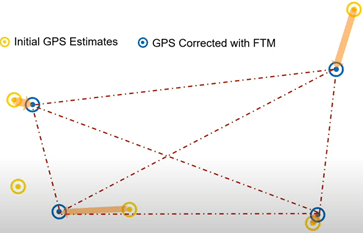
Aruba APs periodically switch to a common channel to perform these time measurements. Aruba Central runs algorithms to find the best anchor APs, so you do not need to do a link budget analysis between potential anchor APs. However, it is interesting to do a link budget analysis.
The charts below were created using the log distance path loss model, frequently called the power law model, where the exponent varies based on the specific propagation environment. This is a common propagation model to use in an indoor environment.
- An obstructed warehouse or factory environment generally has an exponent between 2 and 3. Charts A and B assume an exponent of 2.5. Diagram A calculates the path loss if using channel 36 at 5.18 GHz, and diagram B if using channel 97 at 6.435 GHz.
- An obstructed indoor environment typically has an exponent between 4 and 6.
Charts C and D assume an exponent of 5. Diagram A calculates the path loss if using channel 1 at 2.412 GHz, and diagram B if using channel 36 at 5.18 GHz.
Chart A: 5.18 GHz obstructed warehouse/factory
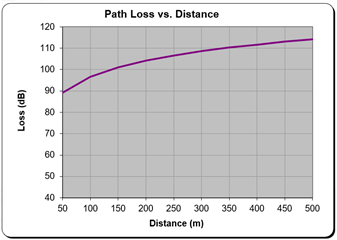
Chart B: 6.435 GHz obstructed warehouse/factory
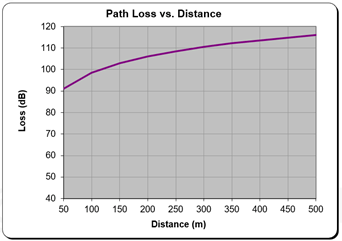
Chart C: 2.412 GHz obstructed indoor environment
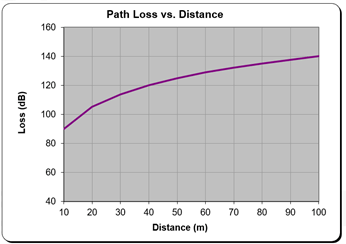
Chart D: 5.18 GHz obstructed indoor environment
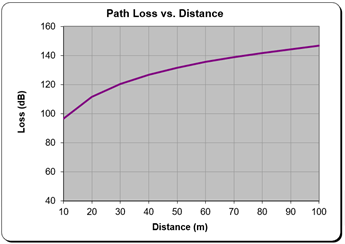
Screenshot credit Ron Bellevich
An example link budget analysis is provided in the footnote[ii] and indicates a maximum path loss of 109dB.
- In an obstructed warehouse/factory environment, if channel 36 5.18 GHz is used, a maximum path loss of 109dB is at 311 meters. If using channel 79 6.435 GHz, the distance must be less than 261 meters.
- In a cluttered indoor environment, if channel 1 at 2.412 GHz is used, the maximum distance is 24 meters. A common channel at 5.18 GHz has a maximum distance of 18 meters.
In conclusion
Based on these calculations, we can expect that Aruba’s self-locating service will work well in open environments like conference centers and sports arenas due to the lack of obstacles in the path between anchor APs. We can also expect it to work well in large obstructed warehouse/factory environments. However, in large indoor buildings with obstacles like office walls, stairwells, and elevator shafts, there is a potential concern that anchor APs may not be able to communicate.
There are several options the Aruba algorithm could use to improve the range of the point-to-point links between the anchor APs in cluttered indoor environments. These options include selecting a low-frequency channel with little interference, reducing the data rate to 1 Mb/s, and a higher transmit power. In particular, these calculations highlight the importance of beamforming for making Aruba's self-locating service successful in large cluttered indoor environments like hospitals and hotels.
The Aruba self-location feature should work in all but the most cluttered RF environments. Stuart Strickland, a fellow at HPE, summed it up well when he said, "we have deployed this in a limited number of environments so far, and we will be gathering more data to figure out how to optimize for specific kinds of environments."
[i] For an explanation of how Aruba’s self-locating feature works, watch the Tech Field Day presentation by Chuck Lukaszewski, Wireless CTO at Aruba, and Stuart Strickland, Fellow at HPE.
[ii] Assuming 21 dBm Tx power, 3 dBi antenna gain, --82 dBm Rx sensitivity (assumes 802.11ax MCS 0, 20MHz channel), no fade margin, then the MAPL is 109 dB (21 + 3 + 3 + 82).




